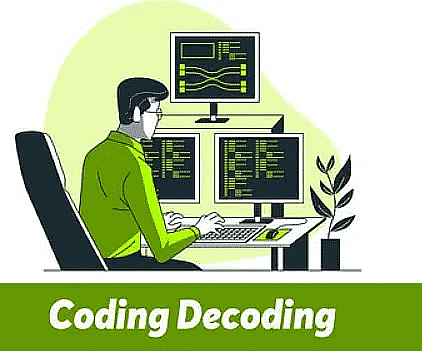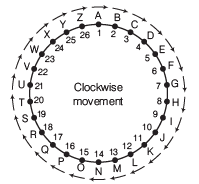Overview: Coding and Decoding | CSAT Preparation - UPSC PDF Download
CSAT Angle
As per the CSAT point of view and the analysis of Previous Years’ Papers it has come to the notice that in the year 2023, two questions and in the years 2022-2016 one question each was asked from this chapter.
Coding-Decoding
Coding-Decoding is the methodology of encrypting and decrypting the words, letters, numbers, sentences, phrases etc., in a manner recognisable only to the sender and intended receiver.

This technique is particularly used for transmitting secret messages from one place to another. These codes are based on certain pattern or principal or rule, which is to be first understood by the receiver and then decode the message following the same rules and principle to reach to the actual meaning or content of the message.
As the matter of fact, there exists no uniform and particular type or category of these questions according to which we could classify questions of coding-decoding.
However, keeping in view the candidate’s convenience we have classified different types of questions with illustrations and explanations under different heads. But before discussing types and illustrations, the knowledge of places of letters is very important. Let us see
Forward Order Position (Left to Right)
Backward Order Position (Right to Left)
Students find it difficult to remember backward order positions but, if they keep forward order positions of letters in their mind, they can easily calculate the backward order position of letters in the following way:
Opposite Letters
Letter opposite to A = 27 − Corresponding position of A = 27 − 1 = 26 = Z
Letter opposite to B = 27 − Corresponding position of B = 27 − 2 = 25 = Y
Letter opposite to C = 27 − Corresponding position of C = 27 − 3 = 24 = X
Letter opposite to D = 27 − Corresponding position of D = 27 − 4 = 23 = W
Letter opposite to E = 27 − Corresponding position of E = 27 − 5 = 22 = V
Letter opposite to F = 27 − Corresponding position of F = 27 − 6 = 21 = U
Letter opposite to G = 27 − Corresponding position of G = 27 − 7 = 20 = T
Letter opposite to H = 27 − Corresponding position of H = 27 − 8 = 19 = S
Letter opposite to I = 27 − Corresponding position of I = 27 − 9 = 18 = R
Letter opposite to J = 27 − Corresponding position of J = 27 − 10 = 17 = Q
Letter opposite to K = 27 − Corresponding position of K = 27 − 11 = 16 = P
Letter opposite to L = 27 − Corresponding position of L = 27 − 12 = 15 = O
Letter opposite to M= 27 − Corresponding position of M = 27 − 13 = 14 = N
Arrangement of Letters
There are two types of arrangement of letters as below:
1. Linear Arrangement (Straight Line Arrangement) When letters of English alphabet i.e. starting from A to Z are arranged along a straight line, then it is called linear arrangement of letters.
2. Circular Arrangement: Circular arrangement is done around a circle. In circular arrangement, letter Z is immediately followed by letter A.
Understanding of linear and circular arrangements is very important as when we have to find the letters forward or backward within the limit of 26 letters of English alphabet, we can use linear arrangement but when we have to find the letters behind A or after Z, then circular arrangement is very useful.
If we have to find the letter one place forward to A, then that letter will be B and this result can be found out by using either linear or circular arrangement but when one is asked to find the letter which is one letter backward of A (Z is one letter backward of A) or one letter forward of Z (A is one letter forward of Z), then only circular arrangement gives such results.
Candidates are suggested to use only circular arrangement while finding forward or backward letters as given below:
e.g.
(i) One letter forward from A = A + 1 = B Two letters forward from A = A + 2 = C
(ii) One letter backward from A = A − 1 = Z Two letters backward from A = A − 2 = Y and so on.
Under this segment of reasoning, following types of questions can be asked
Type I Coding with Alphabets
In such questions, the letters do not stand for themselves but are allotted some other values based on some logical patterns. Questions in letter coding typically provide a word and the encoded version of the word. From these two pieces of information, work out the rule that has been used to encode the word. The candidate may be either asked for the encoded version of a second word or the original version of another encoded word. Once the rule is identified, it applies to all the words that follow the given code.
Letter codes may either involve rearrangement of letters within a word or a word with some other letters based on some rule.
Illustration: In a certain code language, ‘CHILD’ is written as ‘IMOQJ’. How will ‘BABE’ be written in the same language?
(a) HFHJ
(b) FGFK
(c) FFGJ
(d) HFGJ
Sol: (a) The letters of the word are moved six and five steps forward alternately.
As,
Similarly,
Type II Coding with Numbers
The principle of coding with numbers is similar to that of coding with letters only difference is that here digits are used. These digits can be directly coded to the letters or the positional values of letters may be given.
Also, different operationals on positional values of letters may be there.
Illustration: If code for ADHI = 1489, then the code for GIEC is
(a) 7953
(b) 7935
(c) 7593
(d) 7945
Sol: (a) Here, A, D, H and I have been replaced by their position of alphabetical order. Then, GIEC will be coded in the same way. Let us see
Type III Direct Coding
In this type of questions, letters (or numbers) are assigned as code. The questions based on it are comparatively easier as each alphabet is directly coded as a separate symbol.
Illustration: If ‘LOINESS’ is coded as ‘♦ ? # @ φ $$’ and ‘MEN’ is coded as ‘↑ φ @’, then how will you code the ‘MISSION’?
(a) ↑ # $$ # ? @
(b) # ↑ $ ? ♦ φ @
(c) ↑ # $ ♦ ? φ @
(d) ↑ $ # ? ♦ φ @
Sol: Here, no apparent rule of coding is visible in the given codes. Also, given words have E in common and φ is common at the corresponding place in the code. It implies that letters have been assigned direct to the codes. This is nothing but direct coding. Thus, the intelligent deciphering of the two codes given the following
M I S O L E N → ↑ # $ ? ♦ φ @
So, MISSION will be coded as ↑ # $ $ # ? @.
Type IV Coding with Deciphering Message
In this type of questions, some messages are given in the coded language and the code for a particular word is asked. To know the code of each word or of particular word, compare any two messages bearing a common word, doing so, the common code word you get, will be the code of that common word. Proceeding in this way, you will be able to decode the entire message.
Illustration: In a certain code language, ‘col tip mot’ means ‘singing is appreciable’, ‘mot baj min’ means ‘ dancing is good’ and ‘tip nop baj’ means ‘singing and dancing’. Which of the following means ‘good’ in that code language?
(a) mot
(b) min
(c) baj
(d) tip
Sol: (a) Given,
col tip mot → singing is appreciable …(i)
mot baj min → dancing is good …(ii)
tip nop baj → singing and dancing …(iii)
From Eqs. (i) and (ii), mot → is
From Eqs. (ii) and (iii), baj → dancing
From Eq. (ii), min → good
Type V Coding with Substitution
In this type of questions, some words are assigned with certain substitution words and base on this substituted code language, the candidate is asked about the code of a word.
Illustration: If ‘paper’ is called ‘wood’, ‘wood’ is called ‘straw’, ‘straw’ is called ‘grass’, ‘grass’ is called ‘rubber’ and ‘rubber’ is called ‘cloth’, then what is ‘furniture’ made up of?
(a) paper
(b) wood
(c) straw
(d) cloth
Sol: (c) We know that, furniture is made up of wood but in the coding ‘wood’ is called ‘straw’, hence furniture is made up of straw.
Type VI Coding with Condition
Coding with condition is like a group coding means a group of letters or numbers are coding with other symbols or numbers. Also, these are related with direct coding but some conditions are also given.
Direction: (Illustrations) The digits from 0 to 9 are coded as shown below along with the Conditions I and II.
Condition I: If a number begins and ends with a non-zero odd digit, then the first and the last digits are to be coded as Y and #, respectively.
Condition II: If a number begins and ends with an even digit (including zero), then the first and the last digits are to be coded as β and X, respectively.
Illustration 1: What is the code for 764981?
(a) A%ML$@
(b) Y%ML$@
(c) Y%ML$#
(d) A%ML$#
Sol: (c) As the number begins and ends with a non-zero odd digit, therefore the first and the last digit will be coded as Y and #, respectively.
Hence, the code for 764981 is Y%ML$#.
Illustration 2: What will be the code for 278140?
(a) βA$@MR
(b) βA$@MX
(c) KA$@MR
(d) YA$@M#
Sol: (b) As the first and the last digit of the number are even, therefore the first and the last digits are to be coded as β and X, respectively.
Hence, the code for 278140 is βA$@MX.
|
208 videos|272 docs|138 tests
|
FAQs on Overview: Coding and Decoding - CSAT Preparation - UPSC
| 1. What is coding-decoding in the context of the given article? |  |
| 2. How many types of coding are mentioned in the article? |  |
| 3. What is Type III Direct Coding? |  |
| 4. How is Type V Coding with Substitution different from other types of coding? |  |
| 5. Can you explain Type VI Coding with Condition? |  |
















